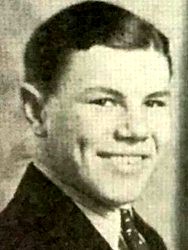The battle of Castle Itter in Austria has been considered as the strangest battle of World War II as it occurred five days after Adolf Hitler’s suicide and two days before the signing of Germany’s unconditional surrender. It was the only battle where American and German soldiers fought alongside one another during the Second World War..

–
Born:
,
Home:
,
Buried:
,
Cemetery:
Awards Received
-

Distinguished Service Cross
-
Distinguished Service Cross
Service:
United States ArmyRank:
Captain (Cavalry), [then First Lieutenant]Batallion:
23d Tank BattalionDivision:
12th Armored DivisionAction Date:
May 4 – 5, 1945
Headquarters, U.S. Forces-European Theater, General Orders No. 212 (August 29, 1945)(Citation Needed) – SYNOPSIS: The President of the United States of America, authorized by Act of Congress July 9, 1918, takes pleasure in presenting the Distinguished Service Cross to Captain (Cavalry), [then First Lieutenant] John Carey Lee, Jr., United States Army, for extraordinary heroism in connection with military operations against an armed enemy while serving with Company B, 23d Tank Battalion, 12th Armored Division, in action against enemy forces in the vicinity of Worgl and at Itter Castle, Austria, on 4 and 5 May 1945. Captain Lee was the Officer in charge during the battle of Castle Itter in Austria. The Castle of Itter had been converted into a high security prison by the Germans for potentially valuable prisoners, it was considered escape-proof due to its massive walls and impregnable gatehouse. The facility was under the operational control of the concentration camp Dachau, ninety miles to the northwest. On 4 May 1945, the SS-Commandant and all the guards, also members of the elite SS, hastily abandoned their posts. The former prisoners started to prepare themselves in case the SS-men would return by gathering weapons and ammunition, which were left behind. Their Czech cook rode a bicycle to the village of Wrgl in the hopes of encountering Allied troops, but instead, he ran into Austrian resistance members who agreed to free the castle prisoners but only with the assistance of American troops. A resistance Major approached the Americans under a white flag at the town square of Kufstein. He was asking for help from Captain Lee, who led Company B of the 23rd Tank Battalion, 12th Armored Division. Captain Lee led the rescue column towards the castle when they came across a small bridge. It was overall in poor condition and wired with demolition charges. Captain Lee decided to cross the bridge and continue the mission only with one M-4 Sherman tank, 14 American servicemen, the resistance Major and 10 German soldiers riding in a truck at the end of the small force. The rest of the convoy remained at the bridge, functioning as rearguard. Captain Lee and his unit ran into a squad of SS troopers who were trying to set up a roadblock. Every man of this joint operation opened fire at the SS-men forcing the SS troopers to withdraw into the surrounding woods. As night began to fall, the rescue unit reached the gates of the castle. Although greeted warmly, they were disappointed about the small size and felt uneasy towards the presence of German soldiers, which formed a part of the rescue unit. Captain Lee positioned the Sherman in front of the main gate so it could command the road. He didn’t have enough vehicles to move his men, the French, and the Germans back to Kufstein. He decided to stay put and wait to be relieved by advancing American forces that were aware of his position. Captain Lee believed that Castle Itter_s thick walls would allow his tiny force to hold off any determined attacker. Just after 11 P.M. that evening, an estimate of 150 advancing Waffen-SS Grenadiers of the 17th SS-Panzergrenadier Division opened fire at the castle and attacked to probe for weaknesses, the attacks lasting throughout the night. Captain Lee ordered the French to hide, but some remained outside and fought among the American and Wehrmacht soldiers. In the early morning hours the SS-men moved in with an 88-mm. anti-tank gun. The American tank crew provided fire support until the 88-mm. gun knocked out their Sherman. The crew was able to escape but the destruction of the tank signaled the main Waffen-SS assault. Several Wehrmacht and American soldiers were also killed from the still firing 88-mm. gun and a well-concealed sniper. Captain Lee’s communication lines had been severed, and he accepted one man’s offer to vault the castle walls and run for help. The runner met lead elements of the 2nd Battalion, 142nd Infantry Regiment near the bridge they have crossed before. More American tanks cautiously crossed the fragile bridge and joined the effort to reinforce Captain Lee’s men. The defenders were running perilously low on ammunition and Captain Lee communicated to his men the next move, which was literally medieval: withdrawal into the castle’s massive keep. There they would use their last remaining bullets to defend every stairwell, hallway or floor. Lee began pulling defenders off the walls and shepherding the French towards the keep. Sensing victory, the SS troops focused their assault on the now undefended castle’s entrance; however, the relief force arrived with tanks in the lead, killing or capturing many SS-men and forcing the others to retreat. Captain Lee’s extraordinary heroism, personal bravery and zealous devotion to duty exemplify the highest traditions of the military forces of the United States and reflect great credit upon himself and the United States Army.

